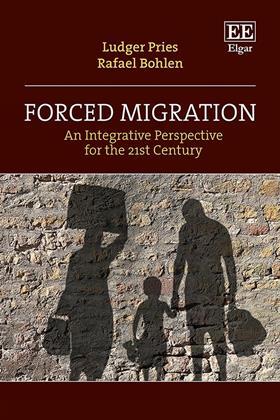Forced Migration: An Integrative Perspective for the 21st Century
Ludger Pries and Rafael Bohlen
£95, Edward Elgar
★★★★✩
Forced Migration is a relatively concise publication (185pp) written by two academics with extensive experience of, and an infectious interest in, migration issues. I refer to ‘academics’ and ‘interest’ because this is not a practitioner’s handbook or reference work to be taken off the shelf from time to time. Rather, for those with a fascination for the subject, this is a book to be read from beginning to end.
The authors see forced migration as a sociological issue rather than one of politics or even economics. The very first illustration shows the rapidly ascending numbers of forcibly displaced persons, amounting to over 100 million by 2022. That forced migration is neither voluntary nor involuntary but always a complex mix is perhaps a prime example of the authors’ insightfulness. The authors recognise, identify and examine the many reasons behind migration, ranging from conflict, political and other crises and gang violence to climate change and its direct and indirect effects. In all of these areas, specific examples or case studies are used to demonstrate the practical and not just the theoretical. The chapter on those affected by forced migration is particularly interesting, showing as it does that all classes of society can be victims dependent on causation. Those who feel forced to migrate find economic capital a crucial facilitator. The authors do not restrict themselves to economic capital, noting also the influence of cultural and social capital. Particular reference is made to vulnerable groups. Children form a sizeable portion of those affected and ‘women and girls’ amount to almost half of forced migrants around the world.

The chapters on ‘Forced migrants as agents in transnational spaces’ and ‘Ambiguities of time and space in forced migration’ give a fascinating consideration of the ‘limbo’ status of those without home or routine. Despite the inevitable constraints they face, forced migrants get on with their lives in some way. I found the penultimate chapter on ‘States and international organizations between human rights and NIMBY’ particularly interesting. This concentrates on the conflict between the principles of protection and the perhaps inevitable ‘not in my backyard’ reaction, and differentiates between the Global South and the Global North. The varying attitudes of specific countries are mentioned and examined. I appreciated the reference to Hannah Arendt and ‘the right to have rights’ but also ‘the new categories of the persecuted’ in this context.
Overall, this book is relevant beyond academia, and is well-resourced and well-referenced throughout. It rewards the reader with a wealth of information and a real appreciation of the complexities of a subject of global importance in the 21st century. The Israeli-Palestine crisis, Sudan and the fall of the Assad regime, among others, assure us that the importance of this subject will not go away.
Julian Phillips is resident judge (Wales and South West England), First-tier Tribunal (Immigration and Asylum Chamber)































No comments yet